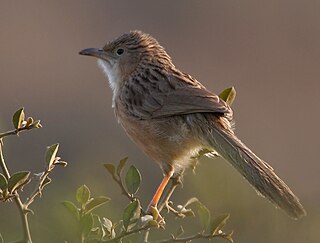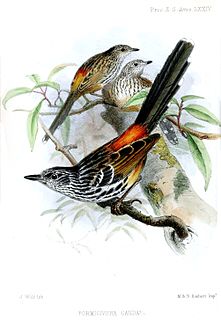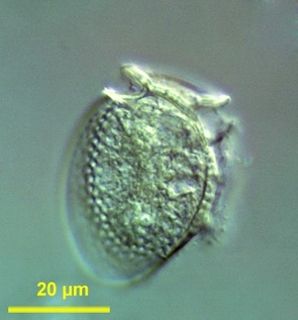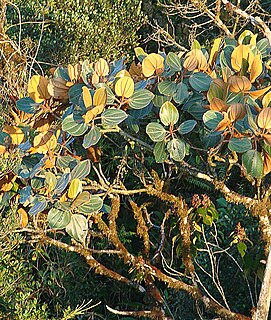
The Caudata are a group of amphibians containing the salamanders (Urodela) and all extinct species of salamander-like amphibians more closely related to salamanders than to frogs. They are typically characterized by a superficially lizard-like appearance, with slender bodies, blunt snouts, short limbs projecting at right angles to the body, and the presence of a tail in both larvae and adults.

The fire belly newts or fire newts are a genus (Cynops) of newts native to Japan and China. All of the species show bright yellow or red bellies, but this feature is not unique to this genus. Their skin contains a toxin that can be harmful if ingested.

The common babbler is a member of the family of Leiothrichidae. They are found in dry open scrub country mainly in India. Two populations are recognized as subspecies and the populations to the west of the Indus river system are now usually treated as a separate species, the Afghan babbler. The species is distinctly long-tailed, slim with an overall brown or greyish colour, streaked on the upper plumage and having a distinctive whitish throat.
The long-tailed birch mouse is a species of jumping mouse found in Northeast Asia. It has been reported from the Ussuri region of Manchuria, Sakhalin Island and Primorsky Krai in Russia, and northern North Korea. It is listed as data deficient by the IUCN.

Birch mice are small jumping rodents that resemble mice with a long tufted tail and very long hind legs, allowing for remarkable leaps. They are native to Eurasian forests and steppes. All variants possess a long tail of 65 to 110 mm of length and weigh about 6 to 14 g. Head and body length of 50 to 90 mm and hind foot length of 14 to 18 mm. The skin color is light brown or dark-brown to brownish yellow on the upper side and paler on the underside, but generally brownish. Birch mice have a vast geographic distribution in that they inhabit a wide variety of habitats, from semiarid areas to subalpine meadows.

Neurergus kaiseri, the Luristan newt, Kaiser's mountain newt, Kaiser's spotted newt or emperor spotted newt, is a species of very colourful salamander in the family Salamandridae. It is endemic to the southern Zagros Mountains in Iran where it is known from just four streams. Populations of this newt have been declining and the International Union for Conservation of Nature has rated it as "vulnerable". A captive breeding programme has been established in several zoos.

The East Andean antbird is a species of bird in the family Thamnophilidae. It is found at high levels in humid highland forests, especially near bamboo, and is endemic to the western slope of the Eastern Andes and the Upper Magdalena Valley in Caquetá and Huila in Colombia. This 15 cm (5.9 in) bird is found at high elevations of about 1,500-2,500 m. It was formerly considered conspecific with the Klages's antbird, the Santa Marta antbird, and the streak-headed antbird and together called the long-tailed antbird.

The long-tailed marmot or golden marmot is a marmot species in the family Sciuridae. It occurs in mountainous regions in the central parts of Asia where it lives in open or lightly wooded habitats, often among rocks where dwarf junipers grow. It is IUCN Red Listed as Least Concern. As suggested by its name, it is a relatively long-tailed species of marmot.
Graffenrieda bella is a species of plant in the family Melastomataceae. It is endemic to Panama. It is threatened by habitat loss.
Graffenrieda harlingii is a species of plant in the family Melastomataceae. It is endemic to Ecuador. Its natural habitats are subtropical or tropical moist montane forests and subtropical or tropical high-altitude shrubland.
Graffenrieda phoenica is a species of plant in the family Melastomataceae. It is endemic to Ecuador. Its natural habitat is subtropical or tropical moist montane forests.
Graffenrieda robusta is a species of plant in the family Melastomataceae. It is endemic to Peru.
Graffenrieda trichanthera is a species of plant in the family Melastomataceae. It is endemic to Peru.
Strelitzia caudata, commonly known as the mountain strelitzia or wild banana, is a species of banana-like Strelitzia from Africa from the Chimanimani Mountains of Zimbabwe south to Mozambique, the Northern Provinces of South Africa and Eswatini (Swaziland). It was first described in 1946 by Robert Allen Dyer in Flowering Plants of Africa, Volume 25, Plate 997. The specific epithet caudata means chopped, this refers to an appendage of a sepal, which occurs only in this species. It is one of three large banana-like Strelitzia species, all of which are native to southern Africa, the other two being S. alba and S. nicolai.

Dinophysis is a genus of dinoflagellates common in tropical, temperate, coastal and oceanic waters. It was first described in 1839 by Christian Gottfried Ehrenberg.

Eupleura caudata is a species of sea snail, a marine gastropod mollusk in the family Muricidae, the murex snails or rock snails. It occurs on the Atlantic Coast of North America.
Eupleura is a genus of sea snails, marine gastropod mollusks in the family Muricidae, the murex snails or rock snails.

Graffenrieda is a genus of flowering plants in the family Melastomataceae. There are about 44 species. Most occur in South America. A few are distributed in Mexico, Central America and the Caribbean.
Cariacothrix is a genus of ciliates in the subphylum Intramacronucleata. It contains only one species, Cariacothrix caudata, and is the only genus in the monotypic family Cariacotrichidae, order Cariacotrichida, and class Cariacotrichea.
Tetragnatha caudata is a species of long-jawed orb weaver in the family of spiders known as Tetragnathidae. It is found in North, Central America, Cuba, and Jamaica.










